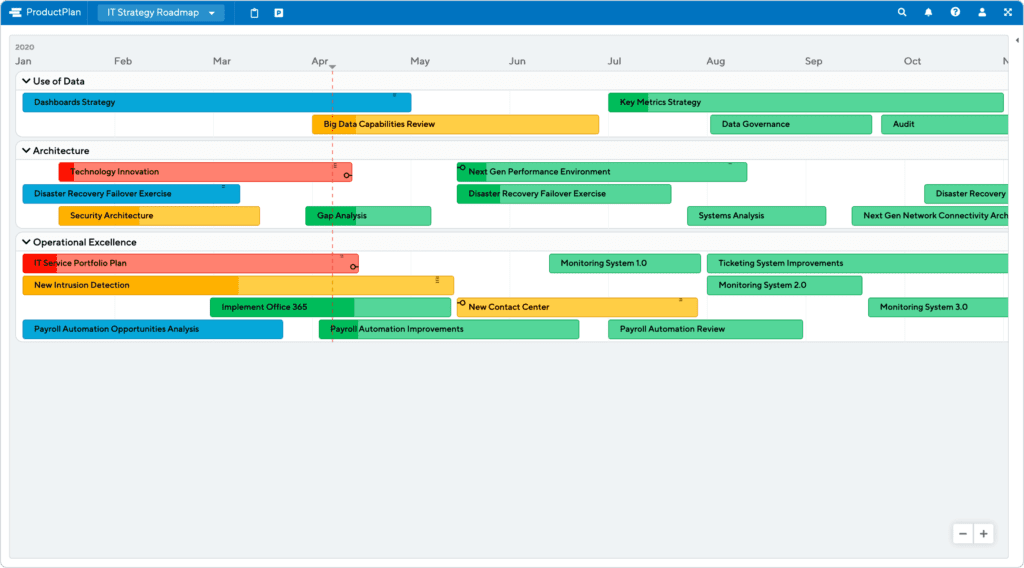Many businesses view their Information Technology team as a reactive, tactical department. In reality, an IT team needs to be strategic. It’s their job to ensure the company has the tools and processes to achieve its business objectives. And although few of them use it, one of the best ways for an IT department to successfully execute its plan is to create an IT strategy roadmap.
In this post, we’ll discuss best practices for developing a roadmap that communicates a company’s high-level IT plans and objectives.
Before we jump into it, though, let’s briefly review the basics. We’ll cover what a roadmap is, then dive into the specifics of the strategic IT roadmap and why your company should have one.
What is a Roadmap, Exactly?
If you’re an IT professional, you might be unfamiliar with the world of roadmapping. So, what is a roadmap? Think of it as a strategic plan for achieving a set of high-level goals. A roadmap won’t include all of the individual tasks needed to reach these goals—only the significant steps and milestones the team will need to complete on their journey to achieving the desired outcome.
Let’s examine what this might look like in practice. In product management, where roadmaps are used all the time, the product team will typically follow this sequence:
First: Establish the product vision or mission.
(Example: “Make it easier than ever for data analysts to find the answers they need.”)
Second: Translate this vision into a strategic plan—the roadmap—which will include the major themes that the team needs to focus on to develop this industry-changing product.)
(Example theme: “Develop APIs to connect more disparate databases easily, so data analysts can discover new data that had previously been locked away due to technical incompatibilities.”)
Third: Break down the high-level strategic themes on the roadmap into a tactical action plan—using a task management app, the product backlog, and other tactical tools.
What is an IT Strategy Roadmap?
As you can see from the above example, the roadmap represents the middle tier in a high-level plan—between the vision and the tactical action steps needed to carry out that vision.
The same is true for an IT strategy roadmap, which should translate a broad vision for a company’s IT infrastructure into a set of strategic steps and milestones needed to achieve that vision. Here’s an example:
IT vision:
Make our workforce more flexible, mobile, and agile in the coming year.
IT strategy roadmap themes:
- Deploy new solutions and apps that enable remote-work capability.
- Move systems, data, and workflows to the cloud.
- Develop IT governance rules for employees working offsite.
Why Should You Create an IT Strategy Roadmap?
Creating an IT strategy roadmap can yield substantial benefits to both the IT department itself and the company as a whole. Here are a few examples.
1. It helps IT play a greater role in achieving the company’s goals.
In any endeavor, if you’re not on offense, you’re on defense. Without a strategic plan guiding the team’s work, an IT department can find itself always in reactive mode. Worse, a department that becomes known simply for responding to employees’ technology troubleshooting requests will have less of an opportunity to help shape the company’s strategic future.
Creating an IT strategy roadmap gives the IT department a proactive plan for contributing to the company’s larger business objectives.
2. It helps IT earn stakeholder approval for its plans and purchases.
An IT strategy roadmap can also help the IT team justify the costs and other resources needed to carry out its proposed technology plans. Without a strategic blueprint highlighting why the team wants to migrate to new technology infrastructure or implement new corporate governance guidelines, an IT department will find it more difficult to earn approval from the heads of the affected departments to move forward.
But if the team can present its plans on a clear and compelling strategic roadmap, earning that buy-in will be much easier.
3. It helps align the organization around shared goals and plans.
In many companies, IT departments operate in silos. They respond to employee requests for help with their technology tools, and they send out company-wide messages when they’re rolling out new systems or changing company rules for using existing applications. But other than these infrequent instances, IT doesn’t regularly collaborate with the rest of the company.
This puts the company at a strategic disadvantage. Every department can benefit from collaborating more closely with IT and letting them know what their department needs to succeed.
The process of creating an IT strategy roadmap will necessitate the IT team working more closely with each area of the business—to learn about their workflows, the challenges they face, and the areas they need help becoming more efficient and effective.
Best Practices for Creating an IT Strategy Roadmap
Now that we’ve reviewed what an IT strategy roadmap is and some of its strategic benefits, let’s discuss tips for developing one for your company’s IT department.
1. Invite input from all areas of the company
An IT strategy roadmap can’t exist in a vacuum. The goal of this roadmap is to help your team develop and execute on a strategy to equip your company with the technological infrastructure to achieve its business objectives. That means you’ll need input from people outside of IT.
To make sure you understand all of your company’s technological needs and goals, you’ll want to involve representatives of each area of your company. For instance, it could include leaders from marketing, sales, engineering, accounting, HR, product management, etc.
2. Plan your roadmap strategy for the medium- to longer-term
Most product roadmaps today include a strategic forecast that goes only a few months into the future. This is particularly true of organizations that follow the agile framework, where the product team aims for frequent product iterations based on continuous market feedback.
In ProductPlan’s 2020 market research report on product managers, for example, we found the majority of product teams plan their roadmaps for a year or less—most going out only between two and six months.
But an IT strategy roadmap can and should cover a longer time horizon. Your work affects many areas of the company and will likely take longer than an iteration to a particular product.
A company-wide transition from on-prem systems to cloud services could take more than a year. Consider, for example, how long it will take to vet vendors and select the right solutions,
train employees on the new tools, draft and implement new governance rules, develop cybersecurity operations around the new infrastructure, etc.
Note: Although the report focuses on product managers, our 2020 report addresses many of the common goals, practices, and challenges involved in creating any type of roadmap. If you’re in IT and new to the roadmapping experience, we believe you can learn a lot from reviewing this report:
3. Include a strategic justification for every roadmap initiative
This is a best practice for roadmapping in general, and creating an IT strategy roadmap is no exception. As we discussed above, one advantage of having a strategic roadmap is that it can help IT managers earn stakeholder buy-in to move forward with their plans.
One of the best ways to earn that buy-in is to include your strategic reasoning for every initiative right alongside that initiative on the roadmap itself.
If you include a roadmap theme to “Implement an online team-messaging app company-wide,” you’ll want to make it clear why you’ve prioritized that initiative. Maybe your answer is, “Our research indicates we’ll realize a 20% increase in staff productivity with a messaging app that employees can use from anywhere to collaborate in real-time with coworkers.”
4. Narrow your roadmap’s focus to only a few major initiatives
When they develop their first roadmap, most teams throw every great idea onto it. This is understandable but counterproductive. You need to be realistic when you create your IT strategy roadmap. Given the limited resources you have, and your other responsibilities, how many major new projects can you make progress on at once?
It’s why prioritizing your roadmap might be the most challenging aspect of creating it. Coming up with ideas won’t be the problem. Both your team and stakeholders from other departments will have plenty of suggestions and requests for new IT initiatives. The challenge will be limiting your roadmap to only a few major strategic goals, and finding a longer-term home—such as a backlog—for all other tasks you can’t focus on today but will prioritize for tomorrow.
Try limiting your roadmap to the top few initiatives that will generate the greatest strategic value for the time invested. You’ll have a reference point to check in with to stay focused on the right strategic initiatives. You’ll find it much easier to politely turn down requests for projects that could steer you off of your strategic path. And you’ll know that your team is always working on the right initiatives—because you’ve already deemed them top priority.
5. Consult with product managers on creating your IT roadmap
If you’re using the right roadmapping software, creating your IT roadmap will be easy from a technological standpoint. The right app will allow you to spin up a new IT roadmap in minutes.
But in terms of how to structure the roadmap, how much detail to include, and the tried-and-true techniques for prioritizing a few key initiatives among the many on your list, you’ll want to consult the roadmap professionals: product managers.
Before you begin hammering out your first IT roadmap, invite your favorite PM to lunch. Then, let them share their wisdom on creating a roadmap that hits all the marks. It should compellingly communicate your IT strategy, earn stakeholder approval, and balance the competing strategic IT needs across the company. It also needs to help align all departments around a shared goal for building stronger technology infrastructure for a better company future.
Want to make your own IT strategy roadmap? Start with our free template.





